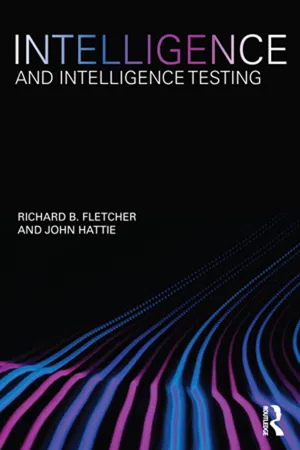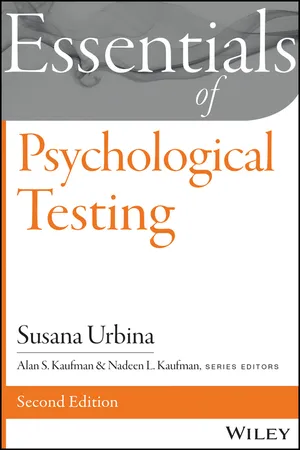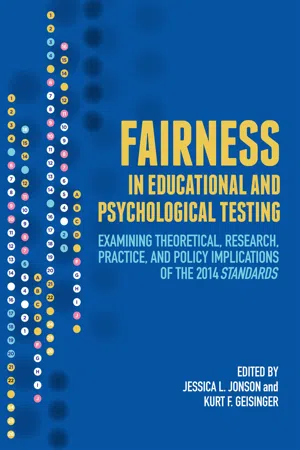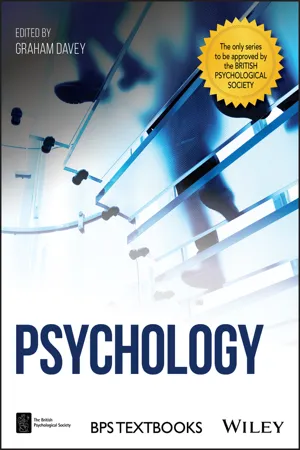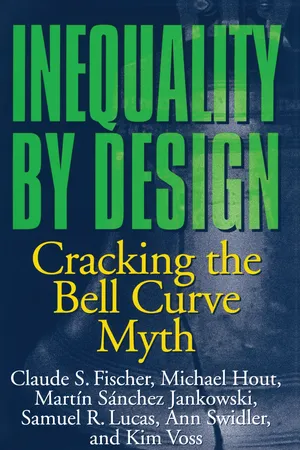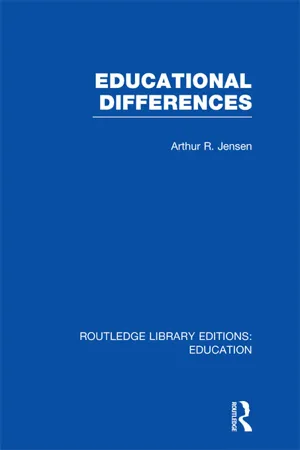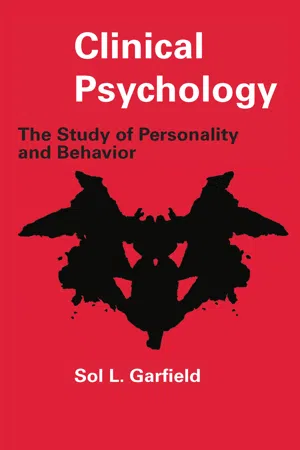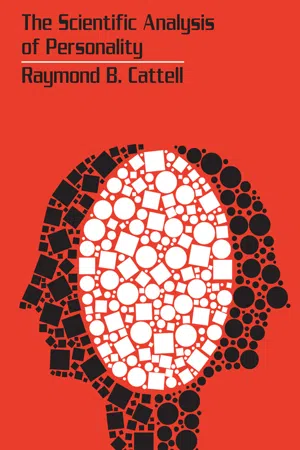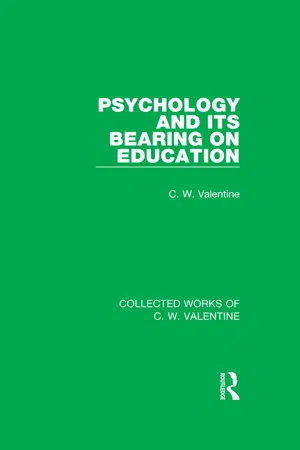Psychology
History of Intelligence Testing
The history of intelligence testing dates back to the late 19th and early 20th centuries, with the development of tests by psychologists such as Alfred Binet and Lewis Terman. These tests aimed to measure cognitive abilities and were initially used to identify students who needed extra support in school. Over time, intelligence testing has evolved and sparked debates about its cultural biases and ethical implications.
Written by Perlego with AI-assistance
Related key terms
Related key terms
1 of 4
Related key terms
1 of 3
10 Key excerpts on "History of Intelligence Testing"
- eBook - ePub
- Nancy Fenton, Jessica Flitter, Jessica Flitter(Authors)
- 2015(Publication Date)
- Research & Education Association(Publisher)
Chapter 13 Testing and Individual DifferencesOur society believes that intelligence is very important; in fact, intelligence tests are used to decide what schools people may attend, what jobs they are qualified for, and whether or not they are capable or brilliant. Interestingly, psychologists generally cannot agree on what exactly intelligence is or an effective way that it can be measured. Experimental psychologist E.G. Boring once famously declared, “Intelligence is what intelligence tests measure.” If that were the only meaning of intelligence, no one but psychologists would care about it. Broadly defined, intelligence involves the capacity to acquire knowledge, reason effectively, and adapt to one’s surroundings by utilizing a combination of inherited abilities (nature) and learned experiences (nurture). Intelligence may be described as a collection of separate abilities or as one significant factor. The study of intelligence is closely related to the field of psychometrics , or the scientific study of using mathematical or numerical methods to measure psychological variables by creating reliable and valid tests. Psychometrics involves the use of a mathematical concept called factor analysis , which utilizes statistics to reduce the number of variables by placing them in clusters of related items. This technique can be used to determine groups of similar variables on a test to determine if an individual’s score on a measure of intelligence is related to one type of ability (factor) or many. In regard to intelligence, it is important that you are able to describe the main theories, the history of testing, and the elements of strong test construction.Intelligence TheoriesAs psychologists have researched intelligence, a variety of different theories have been proposed to explain how intelligence can be defined and potentially measured. The theories differ in terms of how they explain the overall concept. Some theories describe intelligence as one type of ability; others describe intelligence as being comprised of several different abilities. The major theories of intelligence, both historical and contemporary, that are required for the AP Psychology exam are outlined in this chapter. - eBook - ePub
- Richard Fletcher, John Hattie(Authors)
- 2011(Publication Date)
- Routledge(Publisher)
2The brief and sometimes dirty history of intelligence and IQ tests
For many a scientific discipline it would be uncommon to claim that its history has been plain sailing and that its evolution has been uncontroversial. It is because science advances in a cannibalistic manner, devouring old theories for new theories, that anything that challenges the status quo is often met with disdain or disbelief and then the debate becomes embroiled in controversy. A combination of time and evidence, however, often results in new theories taking hold and, like the old ways before them, they become the accepted doctrine – until, that is, another challenger arrives on the scene.Intelligence testing and its history are no exception and, like most branches of science, it has been built on the strengths and weaknesses of previous theory and research. Thus, the present-day notions of intelligence and its measurement stand on diverse theoretical foundations. We should be pleased that there is a diversity in views, as this makes for spirited debate and serves to advance our understanding of this often-misunderstood and controversial concept. Indeed, if the history of IQ and its measurement were not without controversy, this would make for a boring chapter. For the most part, we say the debate is healthy, and long may it continue.As with most historical events, the social norms and ideologies of the day played a significant role in the development of intelligence and IQ testing. These concepts did not develop in a social vacuum and the developers, as well as their practices and outcomes, were very much bound up in the context of the times. We would be the first to admit that there is a tarnished history that sits behind IQ testing, but such a history is what it is – a history – and thus it should not be used to prejudge the current debates on definitions and measurement. Most people today operate in a world of political, social and cultural diversity, as well as equity, which was not the case in the not-too-distant history when IQ testing was emerging. Suffice to say times have changed, and we should be thankful for that; scientists today are more aware of the socio-political climate and are more constrained by the ethical, moral and consequential outcomes of their research. There certainly has been a tendency to ‘politicize the debate on intelligence, or even regard certain issues (pertaining to it) as taboo’ (Howe, 1997: 13). We were also well aware of these reactions throughout the development of the Test the Nation: The New Zealand IQ Test - eBook - ePub
- Susana Urbina, Alan S. Kaufman, Nadeen L. Kaufman(Authors)
- 2014(Publication Date)
- Wiley(Publisher)
The Army Alpha proved to be extremely useful. It was followed rapidly by the Army Beta, a supposedly equivalent test that did not require reading and could thus be used with recruits who were illiterate or non–English speaking. Unfortunately, the haste with which these tests were developed and put into use resulted in a number of inappropriate testing practices. In addition, unwarranted conclusions were made on the basis of the massive amounts of data that quickly accumulated (Fancher, 1985). Some of the negative consequences of the ways in which the Army testing program, and other massive testing efforts from that era, were implemented damaged the reputation of psychological testing in ways that have been difficult to surmount. Nevertheless, through the mistakes that were made early in the history of modern testing, a great deal was learned that later served to correct and improve the practices in this field. Furthermore, with the Army tests the field of psychology decisively stepped out of the lab and academic settings and demonstrated its enormous potential to contribute to real-world applications.After World War I, psychological testing came into its own in the United States. Otis published his Group Intelligence Scale, the test that had served as a model for the Army Alpha, in 1918. E. L. Thorndike, another important American pioneer working at Teachers College at Columbia, produced an intelligence test for high school graduates, standardized on a more select sample (namely, college freshmen) in 1919. From then on, the number of published tests grew rapidly. Procedural refinements were also swiftly instituted in test administration and scoring. For example, test items of different types began to be presented in a mixed order rather than as separate subtests so that an overall time limit could be used for a test, eliminating the need for separate timing of subtests. Issues of administrative standardization, such as eliminating words that could be read with different pronunciations in spelling tests, came to the fore, as did tests' trustworthiness—a term that, at that time, encompassed what is currently meant by reliability and validity (DuBois, 1970).Other Developments in Psychological Testing
The successes achieved with the Binet and Army tests proved their worth in helping to make decisions about people. This soon led to efforts to devise instruments to help in different kinds of decisions. Naturally, the settings where antecedents of psychological tests had arisen—schools, clinics, and psychology labs—also gave rise to the new forms and types of modern psychological tests. - Jessica L. Jonson, Kurt F. Geisinger(Authors)
- 2022(Publication Date)
- American Educational Research Association(Publisher)
Standards ).The Advent of Modern Testing
Many scholars and historians of testing issues (e.g., DuBois, 1970; Geisinger & Usher-Tate, 2016; R. M. Thorndike & Lohman, 1990) have thought that the beginning of modern psychological and educational testing was based on the work of Alfred Binet, a French psychologist who was charged by the Parisian schools with identifying individual pupils who were not able to profit appropriately from the new public schools in Paris. Teachers and others complained that some pupils were simply not able to succeed at school. Previous attempts to assess pupils had been based on factors such as bumps on the head, reaction time, and various other physical and physiological variables, and had not been successful in making useful predictions. Binet and his colleagues, on the other hand, focused on age-appropriate problem-solving skills. They found that tests composed of a variety of these problem-solving skills differentiated students who were able to succeed in schools from those who did not. This work initiated and advanced the understanding of intelligence testing through the next hundred years.Lewis Terman was the most successful of the Americans who translated and adapted the Binet intelligence tests for use with Americans. Given that Terman worked at Stanford University, “Stanford-Binet” was the name of the measure that Terman developed (DuBois, 1970). Working with Terman was another American psychologist, Arthur S. Otis, who was largely credited with developing the first group-administered intelligence test while working with Terman. They correlated intelligence test scores earned in group settings with test scores administered individually by a psychologist and found reasonably good agreement across the administrative modes. Otis’s group-administered intelligence test was the model for the first major use of a group-administered intelligence test in testing recruits for the U.S. military in World War I.- eBook - ePub
- Graham C. Davey(Author)
- 2018(Publication Date)
- Wiley(Publisher)
Intelligence tests are used today in a variety of areas. Perhaps the most obvious application is in school and educational settings, the context in which the first intelligence test was developed. Here, intelligence tests are applied to determine children’s readiness for school or their suitability for a certain type of school. Also, intelligence tests are used to monitor children’s learning and to identify potential learning disabilities. In a similar vein, intelligence tests are used in occupational settings, such as in assessment centres that seek to identify the most suitable candidates for a job.A second field of application for intelligence tests is in the diagnosis of health problems. For example, specially developed intelligence tests are used to test whether people’s cognitive ageing is healthy or whether they may suffer from a form of dementia. Likewise, intelligence tests are administered in psychiatric settings, where they are one of many factors that contribute to formulating a diagnosis.Finally, intelligence tests are widely used in research settings, and not necessarily in the context of intelligence research. For example, they are typically administered to children in studies that investigate autism and cognitive, social, and psychological development.TEST YOURSELF
- What was Francis Galton’s role in intelligence research?
- Describe the first intelligence test in your own words: How and where was it developed? What items did the test include? Who and what was the test for?
SECTION SUMMARY
- The first theories of intelligence and, with that, the foundation of intelligence as a scientific discipline originated in England through the writings of Sir Francis Galton.
- Early on, intelligence was thought to vary between people, to be associated with people’s differences in academic performance, and to be genetically influenced.
- The first measurement tool for assessing individual differences in intelligence came from France, where it was used to detect children with learning disabilities. Since then, intelligence tests have been implemented across the globe, in educational settings and a variety of other contexts.
- eBook - ePub
Inequality by Design
Cracking the Bell Curve Myth
- Claude S. Fischer, Michael Hout, Martín Sánchez Jankowski, Samuel R. Lucas, Ann Swidler, Kim Voss(Authors)
- 2020(Publication Date)
- Princeton University Press(Publisher)
* They highlight the use of IQ tests in the early to mid-twentieth century to promote eugenics, restrict immigration, and defend segregation. (Several prominent psychometricians explicitly allied themselves with coarse racists and Nazi sympathizers.) Based on this history, many dismiss testing.We do not take this approach, for two reasons. First, the history of psychometric testing in other countries shows that it is really a history of the decisions people made about how to use the tests. In the United States, IQ tests were used for discriminatory purposes, but elsewhere, like Great Britain, liberal reformers used similar tests to find promising lower-class children and provide them with opportunities.** Second, IQ and similar tests are widely used by educators and employers as gatekeeping mechanisms to determine who will or will not obtain scarce positions. It is highly unlikely that such tests will be discarded simply because people used them badly in the past. Therefore, we need instead to examine the logic of intelligence testing and its limitations.* See, for example, Huston, Testing Testing; Kamin, “The Pioneers of IQ Testing”; Tucker, The Science and Politics of Racial Research .** See Wooldridge, “Bell Curve Liberals.”We review the chain of reasoning that leads to the psychometric notion of intelligence. We will see that, in practice, the definition of intelligence as “a general capacity for inferring and applying relationships” does not match the procedures psychometricians actually use. The tests, therefore, are not good measures of what most people would consider to be “intelligence.” - eBook - ePub
- Arthur Jensen(Author)
- 2012(Publication Date)
- Routledge(Publisher)
Life. I emphasize ‘present’, because this is my answer as of May, 1968 – not guaranteed to be perfectly correlated with my views on the subject six months or a year from now, although I would surely expect a substantial positive correlation, for we are not totally without bearings in this field. The current pace of relevant re-search, however, is such that anyone who hopes to view these issues constructively and creatively must assiduously eschew a doctrinaire stance.An old issue
The issue of cultural bias or status bias in intelligence tests is as old as intelligence testing itself. Alfred Binet in 1905 made a clear distinction between the kinds of judgment, adaptability, and general problem-solving ability he called intelligence and attempted to measure by means of his mental age scales, on the one hand, and, on the other, the kinds of information acquired in schools or in a cultured home. Despite his efforts to come as close as possible to assessing the child’s innate endowment of general intelligence by means of his scales, he consistently found systematic differences between various social status groups. The first formal study of this social aspect of intellectual assessment was published by Binet just five years after the appearance of the first edition of his now famous intelligence test, which became the prototype of nearly all subsequent individual tests of intelligence (1916). Binet reported evidence from France and Belgium that children of professional workers did better on his new intelligence tests, on the average, than did children in working-class neighborhoods. Since then, the question of social-class bias in tests versus real social-class differences in intelligence has been an issue of dispute among psychologists, sociologists, and educators. Innumerable investigations have been made in the United States, in Europe, and in Asia, of the relationship of social status to performance on intelligence tests. These investigations have used a wide variety of intelligence tests and many different methods of measuring social status. Without a single exception, the studies show a positive correlation between intelligence test scores and social status; half of the studies yield correlations between 0·25 and 0·50, with a central tendency in the region of 0·35 to 0·40. When children selected from the total population are grouped into social status categories, the mean IQs of the groups differ by as much as one to two standard deviations (15 or 30 IQ points), depending on the method of status classification. The fact of social class differences in measured intelligence is thus about as solid a fact as any that we have in psychology, and apparently it has long since ceased being a point of dispute. Most of this evidence has been reviewed by Kenneth Eells et al. - eBook - ePub
Clinical Psychology
The Study of Personality and Behavior
- Max Gluckman, Sol L. Garfield(Authors)
- 2017(Publication Date)
- Routledge(Publisher)
The administration and interpretation of intelligence tests, as we have noted, has a long history in clinical psychology. Even in this traditional activity, however, a broader view has developed concerning the functions and values of intelligence testing. The attainment of an IQ for a particular individual has come to be regarded as merely one purpose of an intelligence examination, instead of the only goal. In general, four main purposes may be served by administering a standardized test of intelligence.1. An Appraisal of the General Intellectual or Mental Level of the Subject. This use of tests for the general purpose of estimating the subject’s mental potentialities or level of functioning is the most common. Frequently, in this connection, the IQ or Mental Age of the subject is used to indicate the level or relative degree of mental ability. One must remember, however, that such tests are not absolute measures and that they possess no magical qualities. They also tend to be largely verbal in content and reflect the educational and cultural opportunities of the individual. Keeping these factors in mind, the psychologist can use the data secured from an intelligence test to help him understand the individual’s mental ability. In many kinds of cases, such information is of value. The following case serves as an illustration of how such results help in clarifying a given client’s difficulties.H. E., a student, was referred to a university psychological clinic because his grades were falling below the minimum required to remain in school. At the time of referral, H. E. was in the fourth semester of his college program and had been given probationary status. Currently, he was failing one subject and barely passing three others. An examination of his record during his first three semesters at college revealed generally poor work, with his grades evenly distributed between C’s and D’s. Since his academic performance was uniformly poor and no unusual trends were noted, it was decided to evaluate H. E.’s mental ability as a possible factor in his school failure. Consequently, an individual intelligence test (Wechsler-Bellevue) was administered to him as the first diagnostic procedure. The test results (IQ above 120) indicated that H. E. was capable of performing at a superior level of mental ability. Because the subject obtained an IQ that was well within the range considered satisfactory for academic success, the test results helped to rule out lack of ability as a serious factor in his school failures. With this information, the psychologist was able to pursue his investigation in other directions and thus uncover more important aspects of the problem. - eBook - ePub
- J. Peter Rothe(Author)
- 2017(Publication Date)
- Routledge(Publisher)
A related but very recent development is the improved accuracy and economy in the actual administration of tests which has been made possible by automation. Seated comfortably in a booth, with no interrupting noises, and headphones conveying instruction in a pleasant voice from the psychologist, several subjects can be tested simultaneously. Dr Herbert Eber, in vocational rehabilitation work, has found it possible to handle far more guidance cases in this way, and with demonstrably improved reliability. There are few psychologists, indeed, working with a stop-watch in an individual testing situation who do not, in distraction, accumulate timing errors. The use of recordings, in automatic test administration, does a better job of standardizing voice tone, time, and several other aspects otherwise not controlled to the degree desirable in a good ‘psychological experiment’.THE NATURE OF INTELLIGENCE IN RELATION TO PERSONALITYDiscussion of school psychology presents the most natural place in this book to raise some debated questions about the interaction of personality and intelligence. Everyone has views about the relative importance of the latter and the layman often has decided views about their mode of interaction in test situations and life situations. Actually, some amateur views on intelligence, though based on little but fiction, turn out to be no stranger than the remarkable facts which research unearths.Let us glance at the history and status of intelligence testing. A phase of construction of intelligence tests on an ‘intuitive’ or at best ‘verbal-theoretical’ basis began with the great success of Binet and Simon in 1905 in putting together an intelligence test which diagnosed mental defect more reliably than had ever been done before. Many imitators appeared, and what began with an inspired construction by two men of genius inevitably ended in a wild proliferation of ‘intelligence tests’ for all kinds of school and industrial use. Lacking any solid scientific basis, such testing practice was soon in theoretical bankruptcy, expressed in the cynical conclusion that ‘intelligence is what intelligence tests measure’. - eBook - ePub
- C.W. Valentine(Author)
- 2015(Publication Date)
- Routledge(Publisher)
Chapter XXIII General Intelligence and Intelligence Tests We have already given in Chapter III a brief account of general and special abilities, as discovered by means of tests. We saw there that there is good evidence for the existence of a large element in general ability which is innate and is not increased by exercise. This general ability is especially revealed in tests which involve the apprehension of relations and that has been further discussed in the chapter on ‘Thinking and the Training of Reasoning’. Intelligence and other tests, however, are so important, and have contributed so much to the development of modern psychology, that we must devote a special chapter to them. We do not propose to discuss in detail the technique of testing. For that, the reader should refer to special books on testing, and for reliable testing a special training is needed. 1 But we must discuss the main ideas underlying intelligence testing, and give an account of their practical uses and of the valuable results they have contributed for psychology and education. Intelligence and general ability. General intelligence has been defined in various ways – as all-round innate intellectual ability or as the capacity for adaptation to relatively novel situations, and so on. The psychologist goes farther; he is not content with the vague popular term ‘intelligence’
Index pages curate the most relevant extracts from our library of academic textbooks. They’ve been created using an in-house natural language model (NLM), each adding context and meaning to key research topics.
Explore more topic indexes
Explore more topic indexes
1 of 6
Explore more topic indexes
1 of 4

